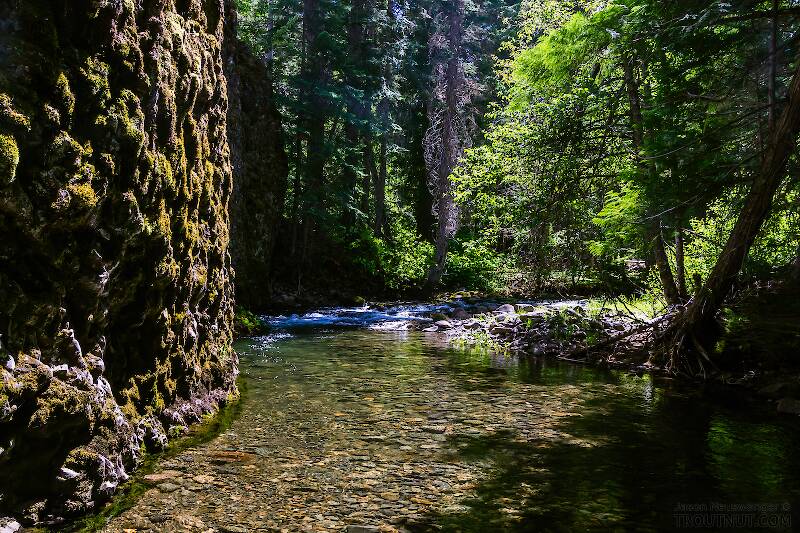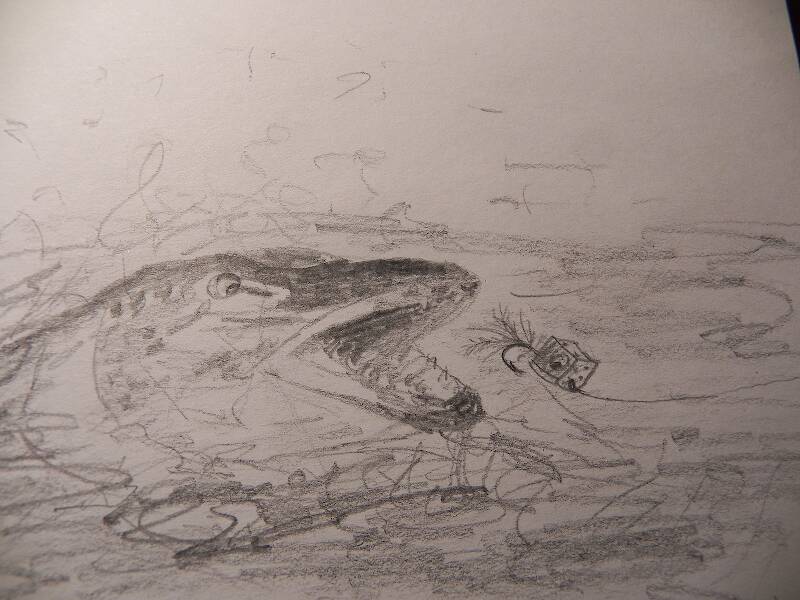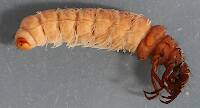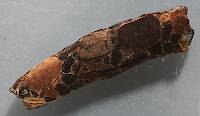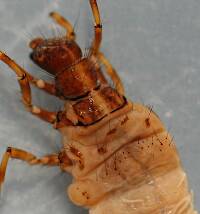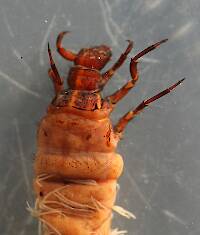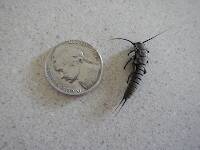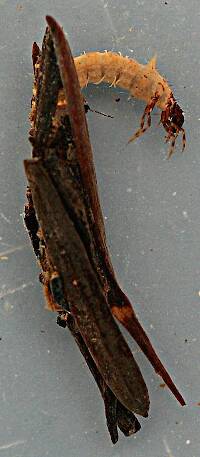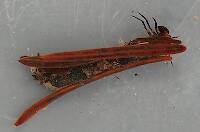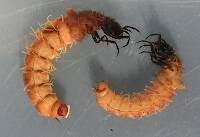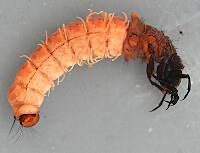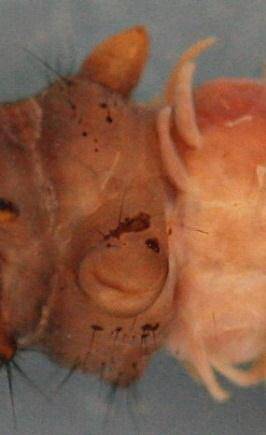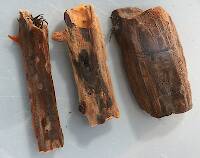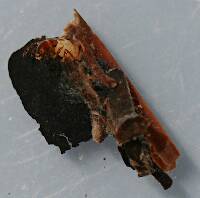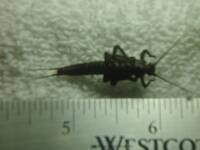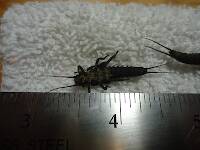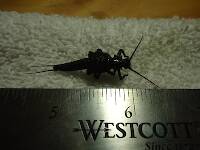
Blue-winged Olives
Baetis
Tiny Baetis mayflies are perhaps the most commonly encountered and imitated by anglers on all American trout streams due to their great abundance, widespread distribution, and trout-friendly emergence habits.
Featured on the forum

This dun emerged from a mature nymph on my desk. Unfortunately its wings didn't perfectly dry out.

Troutnut is a project started in 2003 by salmonid ecologist Jason "Troutnut" Neuswanger to help anglers and
fly tyers unabashedly embrace the entomological side of the sport. Learn more about Troutnut or
support the project for an enhanced experience here.
Stewart711 on Nov 22, 2014November 22nd, 2014, 12:30 pm EST
I came across a dead 15" long female brook trout. I decided to look in its stomach to see what it had been eating. Jammed next to what looked like a ring of muscle at the end of the stomach were (4) pieces of wood, one at 1- 1/2" x 3/8" x 3/8", two pieces at 1-1/2" x 1/4" x 1/4" and a 1-1/2" long 1/8" diameter twig.
Does anyone know anything about behavior like this? Has anybody ever seen anything like this?
Stewart
Does anyone know anything about behavior like this? Has anybody ever seen anything like this?
Stewart
Millcreek on Nov 22, 2014November 22nd, 2014, 1:15 pm EST
Sounds like it may have been eating the larvae of Heteroplectron caddisflies. They hollow out pieces of wood to use as cases. Not sure where you are geographically but there are species of Heteroplectron in the eastern and western states. Here is a link to some photos of the western species - http://www.troutnut.com/topic/8629/Heteroplectron-californicum#42121
You'll need to scroll up to the top to see the photo of the cases of mature larvae. Eastern species have a similar case. If you still have the pieces of wood check to see if they have a hole through them.
You'll need to scroll up to the top to see the photo of the cases of mature larvae. Eastern species have a similar case. If you still have the pieces of wood check to see if they have a hole through them.
"If we knew what it was we were doing, it would not be called research, would it?"
-Albert Einstein
-Albert Einstein
Stewart711 on Nov 22, 2014November 22nd, 2014, 3:08 pm EST
Hello Millcreek
They were definitely tree branch pieces, not those caddis homes.
They were definitely tree branch pieces, not those caddis homes.
Millcreek on Nov 22, 2014November 22nd, 2014, 3:41 pm EST
Stewart711
I tried a Google search for "twigs trout stomach" and twigs seem to end up in trout stomachs fairly often, along with cigarette butts. No real explanation of why they do but maybe they come floating along the top of the water, the fish reacts as if they're food and they're in the stomach before it can spit them out. Be interesting to see if anybody comes up with other ideas about this.
Mark
I tried a Google search for "twigs trout stomach" and twigs seem to end up in trout stomachs fairly often, along with cigarette butts. No real explanation of why they do but maybe they come floating along the top of the water, the fish reacts as if they're food and they're in the stomach before it can spit them out. Be interesting to see if anybody comes up with other ideas about this.
Mark
"If we knew what it was we were doing, it would not be called research, would it?"
-Albert Einstein
-Albert Einstein
Stewart711 on Nov 22, 2014November 22nd, 2014, 3:47 pm EST
Hello again Millcreek
I think the wood chunks caused a blockage and it starved to death. They were really jammed in there, bundled like firewood.
Stewart
I think the wood chunks caused a blockage and it starved to death. They were really jammed in there, bundled like firewood.
Stewart
Troutnut on Nov 23, 2014November 23rd, 2014, 4:42 am EST
I published a scientific paper this year about drift-feeding fish (juvenile salmon in this case) going after debris. Basically, it's more difficult than you'd guess for fish to tell the difference between insects and debris underwater when it's flying at them at high speed in the current and they only have a fraction of a second to decide whether to grab it or let it pass. Normally they're very good at spitting out debris and only swallowing food, though. What might have happened in this case is that the fish had some good meals of cased caddisflies that looked and mostly tasted like twigs recently, so it started swallowing actual twigs without realizing they weren't the same thing. But there are lots of other possibilities.
Jason Neuswanger, Ph.D.
Troutnut and salmonid ecologist
Troutnut and salmonid ecologist
Creno on Nov 25, 2014November 25th, 2014, 1:35 pm EST
Back in the 70-80's I spent several years looking at 100's of fish stomach contents, including brook, cutthroat, rainbow and browns from Colorado. Both brooks and cuts had a major proportion of their "diet" composed of small sticks and pine needles. Most browns and rainbows from the same high elevation habitats lacked sticks and pine needles. I always suspected that the difference was caused by feeding habits with the brooks and cuts focusing on the surface. All the fish were healthy so I guess it didn't bother them enough to pass what they didn't get nourishment from in order to be sure to get whatever else was floating by.
RMlytle on Nov 29, 2014November 29th, 2014, 4:48 am EST
I can't tell enough about you how often I've seen brookies nail those little pine cones and bits of bark. Traditionally, brookies have been found in many places with a lack of food sources. Take your typical small mountain freestone in, say New Hampshire: very little food for insect, very few insects, but still rich with wild brookies. They can only survive by taking everything that comes down their feeding lane. This trait is probably genetically attributable to fishes living in these environments. Rainbows and browns were, traditionally, from more rich water bodies, so it makes sense that they would be more discriminating.
Jmd123 on Nov 30, 2014November 30th, 2014, 5:54 pm EST
Jason, I was in grad school with Mark Wipfli at Michigan State in the late '80s/early '90s! I see he is second author on your paper (Congrats on your Doctorate, Doctor!!) so I assume you know him fairly well? Tell him Jonathon DeNike says hi and has some fun memories to share. Ask him about the Linnean Games when we were all at MSU!
Separate congrats on your "Dr. Troutnut" thread!
Jonathon
Separate congrats on your "Dr. Troutnut" thread!
Jonathon
No matter how big the one you just caught is, there's always a bigger one out there somewhere...
Stewart711 on Dec 1, 2014December 1st, 2014, 3:08 pm EST
What happened here? Is the the "General Discussion of Fly Fishing, Trout and Salmon, and Stream Insects" section or the stroke the administrator section?
Thanks to all for your input.
Stewart
Thanks to all for your input.
Stewart
Quick Reply
Related Discussions
Topic
Replies
Last Reply
7
Jun 25, 2019
by Wbranch
by Wbranch
Brachycentrus americanus on the Lower Sacramento River California
In the Caddisfly Species Brachycentrus americanus by Troutguide
In the Caddisfly Species Brachycentrus americanus by Troutguide
0
Oct 29, 2016
by Troutguide
by Troutguide
8
Oct 15, 2014
by Crepuscular
by Crepuscular

